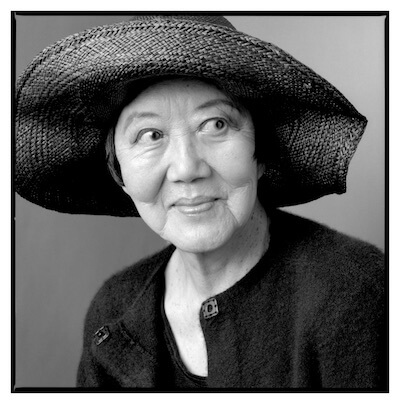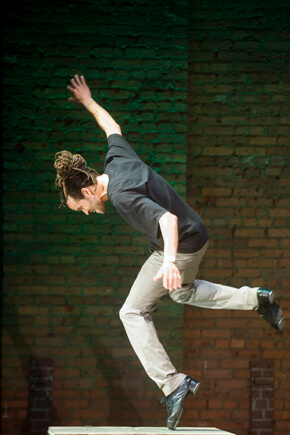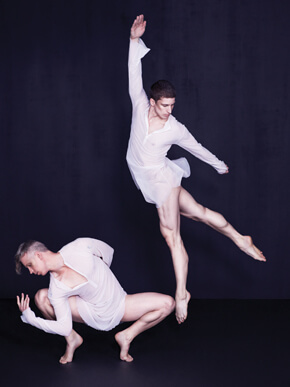Lauren Alzamora and Rashann Callender in Cayetano Soto’s “Sortijas,” set to a song by singer/ songwriter Lhasa de Sela. | PAULA LOBO
On the first of three different programs in its two-week season at the Joyce Theater, Ballet Hispanico danced three works by Spanish dance makers –– a 1983 work by Nacho Duato, a new duet by Cayetano Soto, and a 2012 theatrical concoction by Meritxell Barberá and Inma Garcia.
BH, founded in 1970 by Tina Ramirez and now led by Eduardo Vilaro, has historically been a company of excellent dancers hamstrung by uneven repertory. Its mission is to promote Hispanic choreographers and dancers –– a laudable goal. And the company serves the Hispanic community with school shows and its dance school.
Ballet Hispanico’s brilliant dancers hobbled by their material
But what’s sadder than a professional company of skilled performers without good choreography to showcase their gifts? Opening night couldn’t transcend the company’s traditional choreographic Achilles heel.
The program opened with Duato’s “Jardi Tancat” for three couples wearing peasant costumes in warm, earth tones by the choreographer. A dozen fence posts of varying heights ring the stage, surrounding the close-knit group as they act out prayers for rain, evoking toil, frustration, and endurance in a compositionally predictable framework. There are interesting physical connections, especially in duets, but the support structure of the dance consists mostly of canons, like a dance version of “Row, row, row your boat.” The 30-year-old piece creaks with age.
The closing work, “A Vueltas Con Los Ochenta” (“Back to the Eighties”), looks like choreography by committee. In this case, it’s a two-person committee, Barberá and Garcia, and sadly, neither of them appears to have been in charge of actually creating movement. The piece is “meant to evoke the sights and sounds of Madrid’s 1980s cultural revolution, known as ‘La Movida.’”
It’s meant to be theatrical rather than kinetic, but it remains static, a kind of nostalgic collage stalled by its own self-consciousness. Plus, it’s an odd choice to end the show. When we want all-out dancing, these scenes build neither dynamic nor kinetic tension.
But Diana Ruettiger’s costumes rock! The five men and five women wear sleek, gold-trimmed black outfits. Leather pants, vests, and miniskirts, metallic belts, patterned hose that look like spider webs or tattoos, and sheer mesh shirts all have an intriguing, retro, urban edginess.
In the opening passage of calculated chaos, everybody’s wearing headphones and rocking out to their own individual beats. For the remainder of the ballet, angular tableaus alternate with jazzy, generic classroom routines, driven by the pulsing house beat of music by David Barberá –– perhaps a relative of the choreographer –– and Josh Preston’s animated, disco-influenced lighting. Lights move up and down on battens, shine in our eyes, sometimes saturate the dancers with color, and even flash strobe, all drenched in stage smoke. It looks like a Goth club scene from a movie.
The program’s most impressive dance is a brief pas de deux by Soto, “Sortijas” (“Rings”), set to a song by American-born singer/ songwriter Lhasa de Sela. Munich-based Spaniard Soto –– who also conceived the too-dim lighting, punctuated by blackouts cued by the lyrics –– shows his Euro-contemporary ballet sensibility but it’s, happily, less vehement than most other practitioners of the style. And again, the costumes –– in this case, by Munich-based designer Talbot Runhof –– rule.
Lauren Alzamora, wearing a flashy, silver spangled tunic and black briefs and socks, and Rashann Callender, bare-chested and in tight tuxedo pants and socks, are a gorgeous pair who bring enormous physical commitment and refinement to Soto’s movement.
As the legendary dance educator and mentor Bessie Schoenberg used to say, “A blackout is a cop-out,” and Soto’s seemingly arbitrary blackouts merely interrupt the flow he’s otherwise establishing. It’s a device borrowed from William Forsythe, whose influence on contemporary ballet is ubiquitous. But Forsythe knows how to use it effectively; not everyone does.
No matter how enthusiastically this opening night program was received by the BH fans who filled the audience, the evening was choreographically disappointing. Such terrific dancers deserve more substantial repertory to showcase their technical and expressive skills. Let’s hope there’s sturdier stuff on the season’s other programs.
BALLET HISPANICO | Joyce Theater | 175 Eighth Ave. at 19th St. | Apr. 18-20, 25-27 at 8 p.m.; Apr. 21 & 24 at 7:30 p.m.; Apr. 20-21, 27-28 at 2 p.m. | $10-$69 at joyce.org or 212-242-0800


































